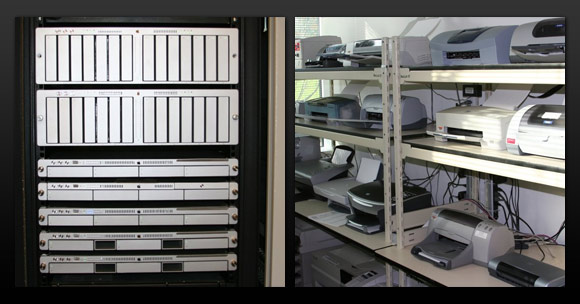(Actually, this isn’t an April Fools’ joke. 😉 )
When you think Microsoft, Linux and Mac isn’t exactly the first thing that comes to mind. But, Microsoft does have test laboratories for open-source software as well as for their Mac products (think MS Office for Mac). Here is a little bit of insight into these “outsiders” inside Microsoft.
The MS Open Source Software Lab
Stephen Zarkos at the Microsoft OSS Lab recently posted an interesting and informative blog entry about what actually goes on at that place.
To some folks outside of Microsoft, the Open-Source Software Lab has been a sort of mysterious place. A place where we study Linux and open-source software, cursing our enemies while brewing our malevolent plans to combat those nasty FOSS developers. Oh, and we also have a death ray on the roof of building 17. It’s Linux-powered, of course, just to add a little irony.
Wow, a death ray!
As you probably have guessed, the reality is that the OSS Lab is just a room full of servers, used by engineers who just love to work with technology. Much of what we do is research, testing and of course there is an educational aspect as well. We all love Linux and open-source, and I almost never take my death-ray to work.
Awww, no death ray…
But it’s still pretty cool. Here are some tidbits:
- Seven racks of servers.
- Big mix of hardware, from old Pentium III blade servers to the latest and hottest, including an IBM POWER6.
- Most are Linux systems, though there are BSD, AIX, Sun and Windows systems as well.

Check out the original post for more information and pictures.
And now it’s time to have a look at the Mac Lab.
The MS Mac Lab
This is from a blog entry from David Weiss at Microsoft. Though this information is a little bit dated by now (from April 2006), it’s still interesting.
- 2,000 square feet filled with Mac computers. (Upon hearing this, Pingdom’s web designer, David, started drooling. 😉 )
- All significant hardware configurations from Apple that run MS products (mainly MS Office, we assume).
- Several automated test rigs for MS Office. One of them has 150 Mac Minis stacked side by side.

There’s also an XServe RAID and XSAN, plus lots of print testing for MS Office:

And much more. There are lots of more pictures in the original blog entry about Mac Labs.
We hope you found this interesting. It’s pretty cool that there are both Mac and Linux enthusiasts working with what they love inside Microsoft. It’s not all about Windows. 🙂



























